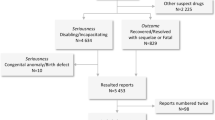Abstract
Background Fluoroquinolone (quinolones) antibiotics are commonly prescribed worldwide. Hypersensitivity reactions to these agents have been reported, but little systematic data exists concerning prevalence, types of reactions, or associated factors. Objective To identify the prevalence of patients reporting an allergy to quinolones, types of reactions claimed, and patient information associated with allergy. Setting A tertiary 370 bed level 1 trauma center, located in a Midwestern City in the United States. Method A retrospective cohort study was conducted. Included in the study were all unique patients 18 years or older admitted to our hospital in 2016 with a length of stay ≥ 24 h. Collected data elements included types of reaction, other drug allergies claimed, and patient characteristics. As a comparator group, an equal sized random sample of patients admitted during the same period reporting penicillin allergy was identified. Main Outcome Measure prevalence and descriptors of quinolone allergy. Results There were 327 patients with a quinolone allergy and 317 patients with a penicillin allergy used as the study sample. Hospital prevalence rate for quinolone allergy was 2%. Hives, rash, and nausea/vomiting were the most common reported reactions. These patients tended to be older than penicillin allergy patients and had an association with concomitant intravenous contrast allergy. Tendonitis or tendon rupture was reported in quinolone patients. Conclusion The prevalence of patients claiming a quinolone allergy in the study hospital was 2%. Common hypersensitivity reactions were reported. Data tended to support a possible association between intravenous contrast allergy and quinolone allergy.

Similar content being viewed by others
References
Trubiano J, Phillips E. Antimicrobial stewardship’s new weapon? A review of antibiotic allergy and pathways to ‘de-labeling’. Curr Opin Infect Dis. 2013;26:526–37.
Picard M, Bégin P, Bouchard H, Cloutier J, Lacombe-Barrios J, Paradis J, et al. Treatment of patients with a history of penicillin allergy in a large tertiary-care academic hospital. J Allergy Clin Immunol Pract. 2013;1:252–7.
Swearingen SM, White C, Weidert S, Hinds M, Narro JP, Guarascio AJ, et al. A multidimensional antimicrobial stewardship intervention targeting aztreonam use in patients with a reported penicillin allergy. Int J Clin Pharm. 2016;38:213–7.
Food and Drug Administration. https://www.fda.gov/downloads/advisorycommittees/committeesmeetingmaterials/drugs/anti-infectivedrugsadvisorycommittee/ucm467383.pdf. Accessed 24 July 17.
Seitz CS, Bröcker EB, Trautmann A. Diagnostic testing in suspected fluoroquinolone hypersensitivity. Clin Exp Allergy. 2009;39:1738–45.
Blanca-López N, Andreu I, Torres Jaén MJ. Hypersensitivity reactions to quinolones. Curr Opin Allergy Clin Immunol. 2011;11:285–91.
Blanca-López N, Ariza A, Doña I, Mayorga C, Montañez MI, Garcia-Campos J, et al. Hypersensitivity reactions to fluoroquinolones: analysis of the factors involved. Clin Exp Allergy. 2013;43:560–7.
Noel GJ, Bradley JS, Kauffman RE, Duffy CM, Gerbino PG, Arguedas A, et al. Comparative safety profile of levofloxacin in 2523 children with a focus on four specific musculoskeletal disorders. Pediatr Infect Dis J. 2007;26:879–91.
Pichler WJ, Srinoulprasert Y, Yun J, Hausmann O. Multiple drug hypersensitivity. Int Arch Allergy Immunol. 2017;172:129–38.
Szebeni J. Hypersensitivity reactions to radiocontrast media: the role of complement activation. Curr Allergy Asthma Rep. 2004;4:25–30.
Kelesidis T, Fleisher J, Tsiodras S. Anaphylactoid reaction considered ciprofloxacin related: a case report and literature review. Clin Ther. 2010;32:515–26.
Liu HH. Safety profile of the fluoroquinolones. Drug Saf. 2010;33:353–69.
Perez E, Callero A, Martinez-Tadeo JA, Hernandez G, Rodríguez-Plata E, Almeida Z, et al. Are skin tests useful in fluoroquinolone hypersensitivity diagnosis? Ann Allergy Asthma Immunol. 2013;111:423–5.
Scherer K, Bircher AJ. Hypersensitivity reactions to fluoroquinolones. Curr Allergy Asthma Rep. 2005;5:15–21.
Acknowledgements
The authors would like to thank the Quality Improvement Department for their assistance in ascertaining initial list of drug allergy patients.
Funding
The authors have no financial support or financial conflicts.
Conflicts of interest
The authors declare that they have no conflict of interest.
Author information
Authors and Affiliations
Corresponding author
Rights and permissions
About this article
Cite this article
Wall, G.C., Taylor, M.J. & Smith, H.L. Prevalence and characteristics of hospital inpatients with reported fluoroquinolone allergy. Int J Clin Pharm 40, 890–894 (2018). https://doi.org/10.1007/s11096-018-0613-0
Received:
Accepted:
Published:
Issue Date:
DOI: https://doi.org/10.1007/s11096-018-0613-0




